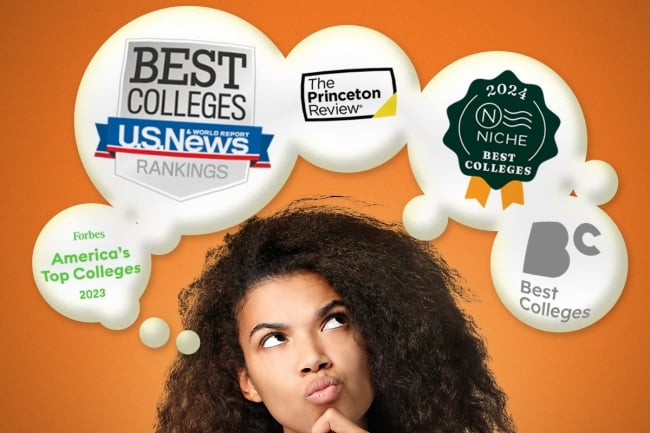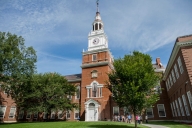You have /5 articles left.
Sign up for a free account or log in.

U.S. News’ “Best Colleges” was still the most commonly used online rankings platform, but its influence has shrunk since 2016.
Photo illustration by Justin Morrison/Inside Higher Ed | Getty Images
There is a stark gap between the premium many college leaders place on the U.S. News & World Report “Best Colleges” rankings and the interests of the prospective students they aim to attract, according to a new report by Art & Science Group, a higher education consulting firm.
While 58 percent of high school seniors who graduated this spring said they actively considered rankings in some way during their search, only 5 percent “thought they knew” the U.S. News ranking of their first-choice school well enough to identify it, the report shows. Even fewer students, about 3 percent, could actually do so correctly.
The report, which was released Tuesday and is based on a survey of just over 800 recent high school graduates, suggests that “U.S. News is not the behemoth that one might think it is,” said David Strauss, a principal at Art & Science Group.
Much speculation has surrounded the credibility of the publication’s traditionally coveted ranking system since Yale Law School announced in fall 2022 that it would no longer take part in the rankings and set off a domino effect of other prestigious law and medical schools dropping out as well.
Some higher education officials thought (and many hoped) that Yale Law’s decision would prompt undergraduate colleges to follow suit. But very few have actually stopped participating in the rankings survey.
That didn’t stop U.S. education secretary Miguel Cardona from urging colleges to stop worshipping at “the false altar” of rankings in March.
Results from the recent Art & Science survey indicate that the rankings still play a “notable but decidedly supporting role” in students’ decisions about college selection, however, and suggest that perhaps college leaders should rethink their level of investment in attempting to move up the ladder of “Best Colleges.”
“We do see a lot of folks in leadership positions, trustees, senior administrators and occasionally faculty … who are inclined to make rankings a significant driver of institutional decision-making,” said Strauss. “But these data would suggest that if that’s being done to satisfy the prospective student market, it may be misplaced goals.”
The survey was conducted between May and July of this year and involved a nationally representative sample of high school graduates who intended to attend a four-year institution full-time this fall.
Only about 25 percent of the students surveyed said they paid attention to any one specific rankings source. For the students who did, U.S. News “Best Colleges” was the most commonly used online rankings platform; 22 percent of students sought rankings information there. But its influence has shrunk since 2016, and survey results now show a 10 percent narrower gap between it and the next most influential ranking source, Niche Best Colleges in America, which was used by 17 percent of the students surveyed.
“Put another way, it appears that for any single ranking source—U.S. News Best Colleges included—three-quarters or more of the traditional, full-time, four-year, college-bound market is paying little attention,” the report states.
The report also found that regardless of student demographics, such as socioeconomic status or performance on standardized tests, the self-reported value they placed on rankings was always “tertiary” to other factors they looked for when selecting a college, including “academic substance, affordability, and safety.”
For example, students who got high marks on the ACT or SAT scored the value of rankings at 7.7, compared to students who got average or low marks, who scored the value of rankings at 6.9 and 7.0 respectively. All three groups scored an institution’s perceived academic quality at about 8.5.
“This is a very broad pool of students nationally … You could imagine that it might evidence a … nuanced use of the rankings,” Strauss said. “And … some populations you would expect to be more engaged with the rankings might be more engaged than the average student is. It’s not enough that it changes their relative position on its importance or even its role.”
Strauss said this does not mean that students don’t think about rankings at all. Rather, the data show that instead of using rankings as “a discrete factor” in their college decisions, prospective students are looking at them broadly “in the abstract.”
Half to two-thirds of the students surveyed who hadn’t looked at rankings, as well as three-quarters or more of those who had, said rankings helped them determine a school’s academic quality, level of prestige and other details, which helped them evaluate an institution based on the “broader idea of stature.”
Students use rankings as a “fact-finding mission,” Strauss said. Rankings help students find “the right neighborhood” rather than the “right street address,” he added.
James Murphy, deputy director of Ed Reform Now, a nonpartisan think tank that does some of its own college rankings, said he was “not surprised” by the findings of the report.
“It echoes what research has shown,” he said. “Which is that college presidents and boards probably put more stock in the rankings than students.”
Murphy also noted that the availability and ease of finding rankings information online has diminished the influence of U.S. News’ rankings.
Students aren’t looking at the numbers in detail, he said. “They just really want an answer to the question ‘is this a good college?’”
And while a few more undergraduate institutions might join the small number of colleges—including Colorado College, Columbia University, the Rhode Island School of Design and Stillman College—who have stopped participating in the U.S. News reputation survey, Murphy believes the results of the Art & Science report will “have no impact on what colleges will do.”
“People should probably stop worrying about them,” Murphy said. “And the survey basically backs that up.”








